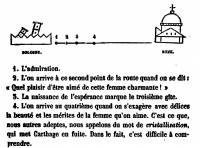Falling in love
From The Art and Popular Culture Encyclopedia
| Revision as of 10:00, 18 January 2022 Jahsonic (Talk | contribs) ← Previous diff |
Revision as of 10:00, 18 January 2022 Jahsonic (Talk | contribs) Next diff → |
||
| Line 24: | Line 24: | ||
| *[[Dating]] | *[[Dating]] | ||
| *[[Flirting]] | *[[Flirting]] | ||
| - | *[[Limerence]] | ||
| *[[Love at first sight]] | *[[Love at first sight]] | ||
| *[[Love sick (anxiety disorder)|Love sickness]] | *[[Love sick (anxiety disorder)|Love sickness]] | ||
Revision as of 10:00, 18 January 2022
|
Related e |
|
Featured: |
"Falling in love" is a mainly Western term used to describe the process of moving from a feeling of neutrality towards someone to one of love. The usage of the term "fall" implies many things: that the process may have been in some way inevitable or uncontrollable, risky or putting the lover in a state of vulnerability, that the process is irreversible, or all of these things, in the same way the word "fall" is used in the phrase "to fall ill" or "to fall into a trap". The term is generally used to describe an (eventual) love that is strong, although not necessarily permanent.
Alberoni Theory
In his socio-psychological theory Francesco Alberoni states that falling in love is a process of the same nature as religious or political conversion.
People fall in love when they are ready to change, or to start a new life.
According to Alberoni, falling in love is a rapid process of destructuration-reorganization called the nascent state. In the nascent state, the individual becomes capable of merging with another person and creating a new collectivity with a very high degree of social solidarity. Hence the definition: falling in love is the nascent state of a collective movement formed of two people only.
In order to understand if someone is truly in love, the individual must be put to truth tests and, in order to find out if he or she is loved in return, the beloved is also put to reciprocal tests. The incandescent process of the nascent state through these tests gives way to certainty and produces a stable love relationship. According to Alberoni, the phenomenology of falling in love is the same for young people and adults, for men and women and for homosexuals and heterosexuals: this is because the structure of the nascent state is always the same.
Unlike the theories consolidated by psychoanalysis, the sociologist does not consider falling in love as a regression, but instead sees it as launching oneself towards the future and change, and thus as fundamental to the formation of a couple in love.
See also
- Limerence
- Infatuation
- Love sickness
- I Fall in Love Too Easily
- Attachment theory
- Dating
- Flirting
- Love at first sight
- Love sickness
- Puppy love
- Romantic orientation
- Transference
References
- Denis de Rougemont, Love in the Western World Pantheon Books, 1956.
- Francesco Alberoni, Falling in Love, New York, Random House, 1983
- Essays in Love, 1993, Alain de Botton



